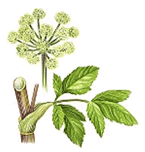
Dong Quai
Introduction
This fact sheet provides basic information about Dong Quai. Dong quai is widely used in traditional Chinese medicine and continues to be popular in China and elsewhere. It is used to treat menstrual disorders, as an analgesic in rheumatism, and in suppressing allergy symptoms. It is promoted for similar uses in the American herb market.
Common Names
Dong Quai, Danggui , Tang-Kuei , Chinese Angelica
Latin Names
Angelica sinensis
What It Is Used For
- Dong Quai, or traditionally known as Chinese Angelica, is commonly used for treating conditions in females in both America and China. Traditional Chinese medicine, frequently refers to Dong Quai as female ginseng.
- Dong quai is often included in herbal combinations as a treatment for abnormal menstruation, including suppressed menstrual flow, dysmenorrhea (painful menstruation), and uterine bleeding.
How It Is Used
Dong quai as a root is often ground into powder and taken in capsule or tablet form. Women usually take 3 to 4 grams per day. Strengths of commercial preparations may vary, so make sure to follow the manufacturer's directions on the label.
What the Science Says
- Dong quai root has been used for over a thousand years as a spice, tonic, and medicine in China, Korea and Japan. Although there are few definitive studies on dong quai.
Side Effects and Cautions
- However it is not recommended, according to Chinese medicine, for treatment of menopause, or related symptoms such as hot flashes. And contrary to some recent theories, donq quai is not a replacement for estrogen, nor does it offer any hormone-like effects on the body.
- Dong quai may cause those with fair skin, to become more sensitive to sunlight.
Sources







